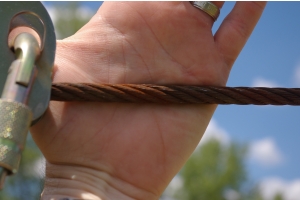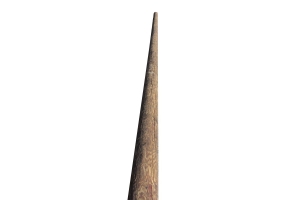Ropes Courses and Challenge Courses
-
August 02, 2020
Wire rope is a mainstay and central component of modern ropes course, challenge course and zip line installations. In teh ropes course and zipline industry we typically utalize flexible wire rope like 1/4" to 3/8" GAC (Galvanized Aircraft Cable)or IWRC (Independant wire rope core) in sizes up to 1". It's important for designers, installers, inspectors and operators to understand some basics on wire rope design and inspection.
Wire rope construction
Wire rope is made up of a number of individual wires that are twisted together. The wires can be made of a variety of materials, including steel, stainless steel, and aluminum. The type of material used will depend on the application. For example, steel wire rope is strong and durable, but it is also heavy. Stainless steel wire rope is corrosion resistant, but it is also more expensive than steel wire rope. Aluminum wire rope is lightweight, but it is not as strong as steel or stainless steel wire rope.
-
February 14, 2020
Belay devices are essential pieces of equipment for rock climbers, ropes course staff, zip line guides, rappellers, and others who work or recreate in high places. They are used to control the rope and prevent falls while climbing or ascending. There are many different types of belay devices available, each with its own advantages and disadvantages.
- Tubular belay devices are the most common type of belay device. They are simple to use and can be used for a variety of applications. Tubular belay devices work by creating friction on the rope as it passes through the device. This friction helps to control the rope and prevent falls.
- Assisted braking belay devices are a type of belay device that helps to reduce the risk of a fall. Assisted braking devices have a mechanism that automatically locks the rope in place if a fall occurs. This can help to prevent serious injury or death.
- Figure-8 descenders are a type
-
November 17, 2019
A rope ascender is a mechanical device that allows you to move up a rope. It is a vital piece of equipment for rock climbers, tree climbers, arborists, ropes course installers, challemnge course technitians, zip line inspectors and other workers who need to ascend ropes for fun or for work.
There are many different types of rope ascenders available, so it is important to choose one that is right for your needs. Some factors to consider when selecting an ascender include:
- The type of rope you will be using. Ascenders are designed to work with specific types of ropes. Make sure to choose an ascender that is compatible with the type and size of rope you will be using.
- The weight capacity of the ascender. Ascenders have different weight capacities, so make sure to choose one that can support your weight and teh weight of any materials and tools connecteed to you or the ascender.
- The type of locking mechanism. Ascenders have different types of locking
-
September 11, 2019
A ropes course and/or zip line harness is one of the most important pieces of gear for an oporator to purchase. It is essential for your staff and participant safety when on a challenge course or zipline, and it can make a big difference intheir comfortand teh overall expericece. There are many different factors to consider when choosing a harness, so it is important to do your research and find the one that is right for you.
Style
Ropes course and zip line harnesses come in a variety of styles: Sit harnesses, sit harnesses with chest harnesses, full body harenesses and specialty harnesses for accessability or being suspended in a prone or superman position. Its imprtant to select a harness that prevents inversion whil eengaging in the activity. While ist common to wear sit harnesses while rock climbing and on some challneg course elements, best practice would be to use a sit harness with a chest harness or better yeat a full body harness.
Materials
-
May 22, 2019
Challenge courses are a great way for people of all ages to get exercise, learn new skills, and have fun. However, they can also be dangerous if not properly supervised. That's why it's important to use the right safety equipment, including a continuous belay system or smart belay system.
A continuous belay system is a type of belay system that uses a segmented or continuous belay cable or track that a lanyard or trolley connects to once without transferring. A lanyard is connected to the belay cable or track with a hook or trolley that can only come on and off at the start and end of the course or with a special tool used by staff or monitors. The lanyard is then attached to the participant’s harness. A continuous belay system prevents users from becoming unclipped while in the air on the ropes course.
A smart belay system is a type of modern lanyard system that uses interconnected
-
November 21, 2018
A pulley is a simple machine that uses a rope and a grooved wheel to lift heavy objects. Pulleys are used in a variety of applications, including cranes, hoists, and elevators, but are also common pieces of hardware and equipment used on challeng coursses, aerial adventure parks and ziplines for rigging, element construction and emergancy rescue.
The parts of a pulley are:
- Grooved wheel: The grooved wheel is the heart of the pulley. It is the part that the rope is wrapped around.
- Axle: The axle is the central shaft of the pulley. It is what the wheel rotates on.
- Bearings: The bearings support the axle and allow it to rotate freely.
- Rope: The rope is what is used to lift the object. It is wrapped around the grooved wheel.
- Sheave: The sheave is the name for the grooved wheel.
When choosing a pulley, there are -
February 27, 2016
Auto belay devices are a new safety innovation that is quickly becoming the standard for challenge courses and ropes courses. Auto belay devices use a variety of sensors to monitor the user's safety and automatically shut off the belay system if there is a fall. This provides an added layer of safety for participants, and it can help to reduce the risk of serious injuries.
History of Auto Belay Devices
The first auto belay devices were developed in the early 2000s. These early devices were bulky and expensive, and they were not widely adopted by the challenge course and ropes course industry. However, in recent years, there has been a significant improvement in the technology and design of auto belay devices. As a result, they are now more affordable, more compact, and easier to use. As a result, they are now being adopted by more and more challenge courses and ropes courses.
How Auto Belay Devices Work
Auto belay
-
May 03, 2015
Working at height is a common occurrence in the ropes course industry. Employees may be required to climb towers, traverse high ropes courses, or work on elevated platforms. As a result, it is important for employers to take steps to ensure the safety of their employees.
One of the most important things that employers can do is to ensure that their employees are properly trained in fall protection. Employees should be trained on how to use fall protection equipment, such as harnesses, lanyards, and lifelines. They should also be trained on how to recognize and avoid fall hazards.
Employers should also provide their employees with the proper personal protective equipment (PPE). This includes hard hats, safety glasses, gloves, and steel-toed boots. Employees should be required to wear this PPE at all times when working at height.
In addition to training and PPE, employers should also implement a fall protection plan. This plan should identify the fall hazards at the worksite








